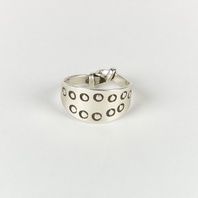
Viking Objects
Reproduction Stamped Finger Ring
A reproduction, stamped, silver ring with knotted ends. Rings with this type of stamped decoration are typical of Scandinavian design during the Viking Age.
Read More
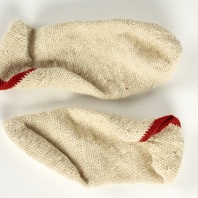
Viking Objects
Reproduction Socks
A pair of reproduction woollen socks based on one found at Coppergate, York. The socks are made using a technique called nålbinding.
Read More
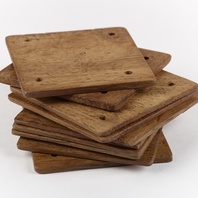
Viking Objects
Reproduction Weaving Tablets
Wooden weaving tablets for creating tablet-woven braids. These are based on examples found in the Oseberg ship burial.
Read More
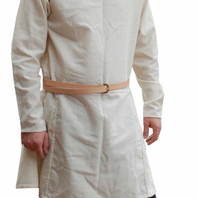
Viking Objects
Reproduction Men’s Clothing Set
The woollen tunic is in white broken diamond twill. Few Viking Age woollen tunics survive intact, but a number of large pieces of skirts and side gores, and arm-hole and sleeve pieces were found at Hedeby, in Denmark. This tunic is made from a composite of all these fragments. The woollen trousers are dark blue/grey herringbone twill. These are based on the archaeological remains of the crotch of a pair of baggy trousers, found at Hedeby, in Denmark, which also appear on a number of Viking Age stone carvings across the Viking world, but particularly in Sweden. The woollen leg-bindingins are yellow herringbone twill, based on original fragments from Hedeby, in Denmark. The vegetable-tanned leather belt, with a ring-and-dot decorated brass buckle, is based on an original found in a male grave (Grave 511), at Repton, Derbyshire.
Read More
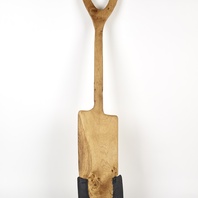
Viking Objects
Reproduction Spade
Spades would have had metal shoes to aid with cutting the ground when digging.
Read More
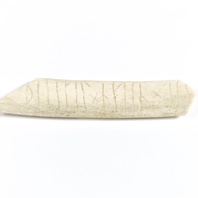
Viking Objects
Reproduction Rune Inscribed Rib
Runes were used not only for monumental inscriptions, or to mark ownership of valuable objects, but also in more informal contexts. In this case the animal bone suggests an after-dinner pastime after a good meal in the Anglo-Scandinavian trading centre of Lincoln. The runes read ——l × hitir × stin × … Only two words of the Old Norse inscription can be read with certainty, and even so they are ambiguous. One possible interpretation is ‘[someone] is heating a stone’ the other is ‘[someone] is called Stein’. The bone is fragmentary, but the inscription may never have been intended to make much sense. The original object dates from around the tenth century. It is one of only three runic inscriptions from the East Midlands.
Read More
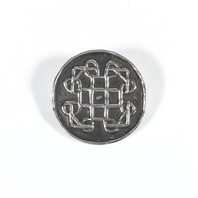
Viking Objects
Reproduction Terslev Brooch
This Borre-style brooch has been identified by Jane Kershaw as a Terslev Type V variant. Terslev style, where Scandinavian ring-chain patterns are the main decorative component, is a subcategory of the Borre style and takes its name from the silver hoard discovered in Terslev, Denmark. The decoration comprises a series of ring-knots related to the Borre ring-chain. The Terslev style occurs mainly on brooches and pendants, including both high-quality gold and silver jewellery as well as lower-end base-metal items. The cast base-metal ornaments, such as those made of copper alloy, were intended to imitate the higher-end gold and silver jewellery, and often employed techniques such as gilding to achieve this. The Terslev designs that occur in England extend the repertoire by introducing new Scandinavian motifs hitherto unrecorded in Scandinavia. For more information on Scandinavian jewellery in England check out our blog: Brooches, Pendants and Pins: Scandinavian Dress Accessories in England.
Read More
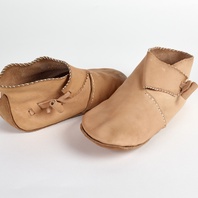
Viking Objects
Reproduction Shoes
A pair of leather turnshoes based on examples found at Coppergate, York. The shoes are vegetable tanned and fastened by a toggle on the side.
Read More
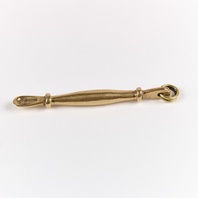
Viking Objects
Reproduction Ear Scoop
An ear scoop (or ear spoon) was a common personal hygiene tool, used for cleaning out the ears. Ear spoons are known from Roman times onwards. They are very common finds on Viking Age sites, suggesting that people took this aspect of personal hygiene very seriously.
Read More
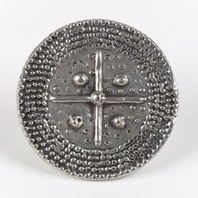
Viking Objects
Reproduction Lead Alloy Brooch
A reproduction of an early medieval, lead alloy brooch found at Barker Gate, Nottingham. Brooches were a typical part of female dress. Scandinavian brooches came in a variety of sizes and shapes which included disc, trefoil, lozenge, equal-armed, and oval shapes. The different brooch types served a variety of functions in Scandinavian female dress with oval brooches typically being used as shoulder clasps for apron-type dresses and the rest being used to secure an outer garment to an inner shift. Anglo-Saxon brooches do not match this diversity of form with large disc brooches being typical of ninth century dress styles with smaller ones becoming more popular in the later ninth and tenth centuries. However, since disc brooches were used by both Anglo-Saxon and Scandinavian women they are distinguished by their morphology. Scandinavian brooches were typically domed with a hollow back while Anglo-Saxon brooches were usually flat. Moreover, Anglo-Saxon brooches were worn singly without accompanying accessories.
Read More
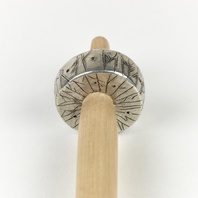
Viking Objects
Reproduction Drop Spindle
A reproduction of a lead alloy spindle whorl with a runic inscription, modelled on a find from Saltfleetby St Clement, Lincolnshire. Fibres were spun into thread using a drop-spindle of which the whorls were made of bone, ceramic, lead, or stone and acted as flywheels during spinning.
